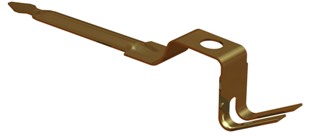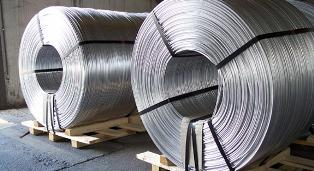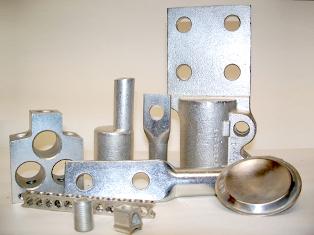Conductive materials in electrical installations
Wires made of copper, aluminum, their alloys and iron (steel) are used as conductive parts in electrical installations.
Copper is one of the best conductive materials. Density of copper at 20 ° C 8.95 g / cm3, melting point 1083 ° C. Copper is chemically slightly active, but easily dissolves in nitric acid and dissolves in dilute hydrochloric and sulfuric acids only in the presence of oxidizers (oxygen). In air, copper quickly becomes covered with a thin layer of dark-colored oxide, but this oxidation does not penetrate deep into the metal and serves as a protection against further corrosion. Copper lends itself well to forging and rolling without heating.
For the production of electrical wires applied electrolytic copper ingots containing 99.93% pure copper.
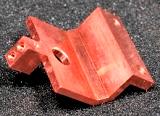 Copper electrical conductivity strongly depends on the amount and type of impurities and to a lesser extent on mechanical and thermal treatment. Copper resistance at 20 ° C is 0.0172-0.018 ohm x mm2 / m.
Copper electrical conductivity strongly depends on the amount and type of impurities and to a lesser extent on mechanical and thermal treatment. Copper resistance at 20 ° C is 0.0172-0.018 ohm x mm2 / m.
For the production of wires, soft, semi-hard or hard copper with a specific weight of 8.9, 8.95 and 8.96 g / cm.3 is used, respectively.
Copper in alloys with other metals is widely used for the production of live parts... The following alloys are the most widely used.
Brass - an alloy of copper with zinc, with a content of at least 50% copper in the alloy, with additions of other metals. Resistance brass 0.031 — 0.079 ohm x mm2 / m. Distinguish between brass — red brass with a copper content of more than 72% (it has high plasticity, anti-corrosion and anti-friction properties) and special brass with additions of aluminum, tin, lead or manganese.
Bronze — an alloy of copper and tin with additives of various metals. Depending on the content of the main component of bronze in the alloy, they are called tin, aluminum, silicon, phosphorus, cadmium.  Resistance of bronze 0.021 — 0.052 ohm x mm2/m.
Resistance of bronze 0.021 — 0.052 ohm x mm2/m.
Brass and bronzes are distinguished by good mechanical and physico-chemical properties. They are easy to process by casting and pressure, resistant to atmospheric corrosion.
Aluminum — in terms of its qualities, the second conductive material after copper. Melting point 659.8 ° C. Density of aluminum at 20 ° — 2.7 g / cm3... Aluminum is easy to cast and works well. At a temperature of 100 — 150 ° C, aluminum is forged and ductile (it can be rolled into sheets up to 0.01 mm thick).
Electrical conductivity of aluminum strongly depends on impurities and little on mechanical and heat treatment. The purer the aluminum composition, the higher its electrical conductivity and better resistance to chemical attack.Machining, rolling and annealing have a significant effect on the mechanical strength of aluminium. Cold working of aluminum increases its hardness, elasticity and tensile strength. Resistance of aluminum at 20 ° C 0.026 — 0.029 ohm x mm2/ m.
When replacing copper with aluminum, the cross-section of the wire must be increased relative to the conductivity, that is, by 1.63 times.
With the same conductivity, the aluminum wire will be 2 times lighter than copper.
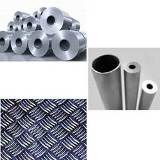 For the production of wires, aluminum is used, containing at least 98% pure aluminum, silicon no more than 0.3%, iron no more than 0.2%
For the production of wires, aluminum is used, containing at least 98% pure aluminum, silicon no more than 0.3%, iron no more than 0.2%
For the production of live parts, use aluminum alloys with other metals, for example: Duralumin - an alloy of aluminum with copper and manganese.
Silumin — a light alloy of aluminum with an admixture of silicon, magnesium, manganese.
Aluminum alloys have good casting properties and high mechanical strength.
The following are the most widely used aluminum alloys in electrical engineering:
Wrought aluminum alloy of class AD with aluminum not less than 98.8 and other impurities up to 1.2.
Wrought aluminum alloy class AD1 with aluminum not less than 99.3 and other impurities up to 0.7.
Wrought aluminum alloy, class AD31 with aluminum 97.35 — 98.15 and other impurities 1.85 -2.65.
Alloys of grades AD and AD1 are used for the manufacture of housings and dies for hardware brackets. Profiles and rubbers used for electrical wires are made of alloy grade AD31.
Aluminum alloy products, as a result of heat treatment, acquire high maximum strength and density (creep) limit.
Iron — melting point 1539 ° C. The density of iron is 7.87. Iron dissolves in acids, is oxidized by halogens and oxygen.
Different types of steel are used in electrical engineering, for example:
Carbon steels — forged alloys of iron with carbon and other metallurgical impurities.
Resistance of carbon steels 0.103 — 0.204 ohms x mm2/m.
Alloy steels — alloys with additions of chromium, nickel and other elements additionally added to carbon steel.
Steels are good magnetic properties.
As additives in alloys as well as for solder production and performance protective coatings electrically conductive metals are widely used:
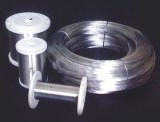 Cadmium is a malleable metal. The melting point of cadmium is 321 ° C. Resistance 0.1 ohm x mm2/m. In electrical engineering, cadmium is used to prepare low-melting solders and for protective coatings (cadmium coating) on the surface of metals. In terms of its anti-corrosion properties, cadmium is close to zinc, but cadmium coatings are less porous and are applied in a thinner layer than zinc.
Cadmium is a malleable metal. The melting point of cadmium is 321 ° C. Resistance 0.1 ohm x mm2/m. In electrical engineering, cadmium is used to prepare low-melting solders and for protective coatings (cadmium coating) on the surface of metals. In terms of its anti-corrosion properties, cadmium is close to zinc, but cadmium coatings are less porous and are applied in a thinner layer than zinc.
Nickel — melting point 1455 ° C. Resistance of nickel 0.068 — 0.072 ohm x mm2/m. At normal temperatures it is not oxidized by atmospheric oxygen. Nickel is used in alloys and for a protective coating (nickel plating) on the surface of metals.
Tin — melting point 231.9 ° C. Resistance of tin 0.124 — 0.116 ohm x mm2 / m. Tin is used for soldering a protective coating (tinning) of metals in pure form and in the form of alloys with other metals.
Lead — melting point 327.4 ° C. Resistivity 0.217 — 0.227 ohm x mm2/ m. Lead is used in alloys with other metals as an acid-resistant material. It is added to solder alloys (solders).
Silver — a very malleable, malleable metal. The melting point of silver is 960.5 ° C. Silver is the best conductor of heat and electricity.Silver resistance 0.015 — 0.016 ohm x mm2/m. Silver is used for a protective coating (silver) on the surface of metals.
Antimony — shiny brittle metal, melting point 631 ° C. Antimony is used as additives in soldering alloys (solders).
Chrome — a hard, shiny metal. Melting point 1830 ° C. Does not change in air at normal temperatures. Chromium resistance 0.026 ohm x mm2/m. Chromium is used in alloys and for protective coating (chroming) of metal surfaces.
Zinc — melting point 419.4 ° C. Resistance of zinc 0.053 — 0.062 ohm x mm2/ m. In moist air, zinc oxidizes, covering itself with a layer of oxide that protects against subsequent chemical influences. In electrical engineering, zinc is used as an additive in alloys and solders, as well as for a protective coating (galvanizing) on the surfaces of metal parts.

